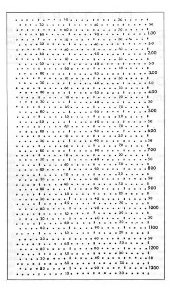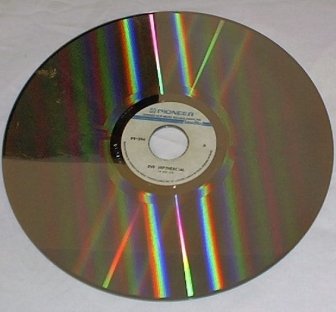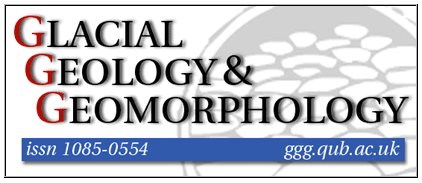Mining the Archive: The Development of Electronic Journals
Martin White looks through the Ariadne archive to trace the development of e-journals as a particular aspect of electronic service delivery and highlights material he considers as significant.
My career has spanned 42 years in the information business. It has encompassed 10,000-hole optical coincidence cards, online database services, videotext, laser discs, and CD-ROMs, the World Wide Web, mobile services and big data solutions. I find the historical development of information resource management absolutely fascinating, yet feel that in general it is poorly documented from an analytical perspective even though there are some excellent archives.
These archives include the back issues of Ariadne from January 1996. Ariadne has always been one of my must-reads as a way of keeping in touch with issues and developments in e-delivery of information. The recently launched new Ariadne platform [1] has provided easier access to these archives. Looking through its content has reminded me of the skills and vision of the UK information profession as it sought to meet emerging user requirements with very limited resources. The archives have always been available on the Ariadne site but the recent update to the site and the availability of good tags on the archive content has made it much easier to mine through the archive issues.
The Ariadne team, in particular Richard Waller, has given me the opportunity to mine those archives [2] and trace some of the developments in electronic service delivery in the UK.
Indeed working through the archives is now probably too easy as in the preparation of this column I have found myself moving sideways from many of the feature articles to revel in the other columns that have been a feature of Ariadne. This article is a personal view of some of these developments and is in no way intended to be a definitive account. Its main purpose is to encourage others to look into the archive and learn from the experiences of the many innovators that have patiently coped with the challenges of emerging technology, resource limitations and often a distinct lack of strategy and policy at both an institutional and government level.

Figure 1: Optical coincidence card, circa 1970
e-Journal Development
Arriving at the University of Southampton in 1967 my main surprise was not the standard of the laboratories but the quality and scale of the Chemistry Department library. School does not prepare you for reading primary journals and how best to make use of Chemical Abstracts, but I quickly found that working in the library was much more fun than in a laboratory. I obtained an excellent result in one vacation project on physical chemistry problems by reverse engineering the problems through Chemical Abstracts! Therefore, as it turned out, I had started my career as an information scientist before I even graduated. By 1977 I was working with The Chemical Society on the micropublishing of journals and taking part in a British Library project on the future of chemical information. Re-reading the outcomes of that project makes me realise how difficult it is to forecast the future. Now my past has re-asserted itself to good effect as I have both the honour and excitement of being Chair of the eContent Committee of the Royal Society of Chemistry.

Figure 2: Laser disc, circa 1980
So from my standpoint, in seeking to identify distinct themes in the development of information resource management in Ariadne, a good place to start is with the e-markup of chemical journals. In Issue 1 Dr Henry Rzepa wrote about the potential benefits of the semantic markup of primary journals to provide chemists with access to the content of the journal article and not just to a contents page and title [4]. The immediate problem you face reading this admirable summary of the potential benefits of markup is that many of the hyperlinks have disappeared. History has been technologically terminated. Almost 15 years passed by before the Royal Society of Chemistry set up Project Prospect and turned semantic markup into a production process [4]. Dr Rzepa is now Professor of Computational Chemistry at Imperial College, London.
By the mid-1990s good progress had been made in e-journal production technologies and the first e-only journals were beginning to appear. Among them was Glacial Geology and Geomorphology (GGG) which existed in a printed version only in as far as readers could print out a selection from it. One aim of GGG is therefore to provide the benefits of electronic transfer as well as other value added products in an accepted academic, peer-reviewed system. The author of the article describing the project [5] was Dr. Brian Whalley, who went on to become a Professor in the Geomaterials Research Group, Queens University of Belfast. As you will discover from his author profile (another Ariadne innovation), Brian is still active though retired from formal education. What struck me about this article was the author’s vision in January 1996 of how e-journals could be of benefit in university teaching.

Figure 3: Glacial Geology and Geomorphology
You will perhaps have sensed that I want to highlight the role of individuals who have made a substantial contribution to the development of our current information environment. I first met Dr. Fytton Rowland when he was the secretary to the British Library project on the future of chemical information around 1976. Fytton Rowland remains one of the most insightful of analysts on the development of STM (Science, Technology and Medicine) publishing and you can see the evidence for that in his defence of print journals in 1997 [6].

Figure 4: Fytton Rowland, circa January 1997
“Most of the major scholarly publishers are now offering their journals in parallel print and electronic forms. I believe that the commercial publishers will come under intense pressure to use the new technology to reduce their prices. The current position where the electronic version costs the same as or more than the printed is untenable, given the financial position of the libraries that are their major customers. The large publishers, both for-profit and not-for-profit, argue that ceasing to print their journals will save only a small proportion of their total budget, and that in the intermediate period when publication is in dual form, their costs are actually raised by the need to provide both forms. The radicals who argue for a complete reform of the system use zero-based budgeting to demonstrate that costs could be drastically lowered, if new electronic-only journals were started from scratch. It is hard to predict where this argument will end. However, the library budget crisis combined with the increased determination of universities to retain the intellectual property rights in their research seems likely to require some compromise from publishers.”
Scholarly Journals in Transition
In 1996 the Higher Education Funding Council for England (HEFCE) took a remarkable initiative to set up a UK-wide Pilot Site Licence Initiative for e-journals. This initiative was the outcome of discussions which took place in 1994 between a small number of publishers and the Higher Education Funding Council for England (HEFCE) [7]. The result was a three-year experiment involving four publishers - Academic Press, Blackwell Science, Blackwell Publishing and the Institute of Physics Publishing. These publishers offered access to their entire journal collection for between 60% and 70% of the normal price. A number of regional site licence agreements had been set up in the USA but nothing on the geographic scale of the HEFCE initiative.
The reaction from the serials community was very positive and there was a willingness on the part of serials librarians, publishers and subscription agencies to work together to resolve the many open issues. A sense of the ethos of co-operation can be gauged from a report of a meeting of the community in mid-1997 that was recorded in Ariadne later in the year [8]. On the day of the meeting it was announced that the successor to PLSI would be managed by JISC. Rarely has a meeting been so well timed!
Moreover, in that same November 1997 issue (12), there is a very good overview of the on-going debate at that time on the future of printed journals by Tony Kidd, Head of Serials at Glasgow University Library [9]. His article illustrates the openness of the serials community to find ways to take advantage of e-journals and still maintain access to printed versions of journals. I was one of the team of consultants who undertook a review of the PLSI for HEFCE and visited a substantial number of UK universities as well as publishers and other stakeholders. Although there were concerns about many of the implications of e-journals and site licensing, there was a very strong common commitment to addressing them. The result was that the Mark II licence was seen the world over as a template for national site licensing. Much of the credit for this must go to the UK Serials Group, whose conference was and is the forum at which these concerns were aired, debated and resolved. Tony Kidd remains associated with the University of Glasgow as Assistant Director of the Library and has been Chairman of UKSG.
Open Access
By 1998 the balance was already moving towards e-journals as the primary delivery channel. Michael Day, by then at the UK Office for Library and Information Networking (latterly UKOLN), wrote a masterly overview of the state of play in 1999 [10]. The catalyst for this was the development of the PubMed open access service that would provide free access to papers on the biomedical sciences. PubMed was conceived by Harold Varmus, Nobel Prize winner and director of the US National Institutes of Health (NIH) who in 1999 circulated a proposal for an online service that would give free access to published material in the biomedical sciences.
Michael opened his paper with a quotation from F. Wilfred Lancaster, who was born in the UK but spent most of his professional career in the USA.
In my opinion, there is no real question that completely paperless systems will emerge in science and in other fields. The only real question is "when will it happen?" We can reasonably expect, I feel, that a rather fully developed electronic information system ... will exist by the year 2000, although it could conceivably come earlier.
This forecast dates from 1978 and gives a measure of the vision of Wilf Lancaster. I only met him once but his enthusiasm for moving information science forward remains with me to this day. Meanwhile Michael has gone on to lead the team which he joined at UKOLN in 1996.
So far I notice that I have not mentioned Stevan Harnad. More than anyone else Harnad has driven the discussion around open access publishing. The concept of Green and Gold open access date back to the Budapest Open Access Initiative in 2002 and the BOAI has itself just reviewed the progress that has been made over the last ten years [11] To me, Harnad wrote one of the seminal contributions in the Green/Gold debate [12] It remains essential reading, all the more so since the publication of the Finch report earlier this year [13].
Archiving Digital Content
The focus so far of this review has been on the delivery of e-journals but there is another important aspect and that is how to store them for the future. This is an especially important debate in the UK where, 10 years after the changes to the Copyright Act to accommodate electronic media, the discussions about the implementation of the Act are still underway, with some hope of resolution in 2013. I need to go back to 1995 and the development of the JStor e-archive with support from the Mellon Foundation. By 1998 it was clear that the approach taken by JStor had very significant merit and a UK JStor was set up at MIMAS, University of Manchester. The background and early history of the UK JStor is recorded by Alison Murphy [14] and the development of Portico by Eileen Fenton [15]. Both these services have transformed the provision of digital resources to the research and academic communities.
Conclusion
In reviewing these articles some lessons from this brief history became very evident to me. First there is the importance of listening to people with vision, even if they seem at odds with conventional wisdom. Wilf Lancaster, Harold Varmus and Stevan Harnard are just three of these people. What also comes across in this brief history is the willingness of the information profession to work together to solve seemingly intractable problems. In the development of e-journal delivery, the UK Serials Group has to take a lot of credit for bringing stakeholders together on multiple occasions.

Figure 5: United Kingdom Serials Group
Finally we need to appreciate that technology itself will not deliver value unless the content is also of value. The Pilot Site Licence Initiative was a success primarily because of the reputation of the four publishers involved and the quality of their journals.
References
- Richard Waller. "Editorial: Welcome to New Ariadne". March 2012, Ariadne Issue 68 http://www.ariadne.ac.uk/issue68/editorial1/
- Ariadne: Overview of back issues archive http://www.ariadne.ac.uk/issues
- Henry Rzepa. "CLIC: An Electronic Chemistry Journal". January 1996, Ariadne Issue 1 http://www.ariadne.ac.uk/issue1/clic/
- Royal Society of Chemistry: Project Prospect http://www.rsc.org/Publishing/Journals/ProjectProspect/
- Brian Whalley. "Electronic Journals, Evolutionary Niches". May 1996, Ariadne Issue 3 http://www.ariadne.ac.uk/issue3/ggg/
- Fytton Rowland. "Print Journals: Fit for the Future?". January 1997, Ariadne Issue 7 http://www.ariadne.ac.uk/issue7/fytton/
- Judith Edwards. "Electronic Journals: Problem Or Panacea?". July 1997, Ariadne Issue 10 http://www.ariadne.ac.uk/issue10/journals/
- Jim Huntingford. "Consortium and Site Licensing". November 1997, Ariadne Issue 12 http://www.ariadne.ac.uk/issue12/consortium
- Tony Kidd. "Are Print Journals Dinosaurs?". November 1997, Ariadne Issue 12
http://www.ariadne.ac.uk/issue12/main/ - Michael Day. "The Scholarly Journal in Transition and the PubMed Central Proposal". September 1999, Ariadne Issue 21 http://www.ariadne.ac.uk/issue21/pubmed/
- Electronic Frontier Foundation. "Budapest Open Access Initiative Launches New Recommendations for the Next 10 Years of Open Access". Deeplinks Blog, 21 September 2012
https://www.eff.org/deeplinks/2012/09/BOAI-10th-anniversary-new-recommendations - Stevan Harnad. "Fast-Forward on the Green Road to Open Access: The Case Against Mixing Up Green and Gold". January 2005, Ariadne Issue 42 http://www.ariadne.ac.uk/issue42/harnad/
- "Accessibility, sustainability, excellence: how to expand access to research publications", ("Finch Report"). Report of the Working Group on Expanding Access to Published Research Findings, June 2012 http://www.researchinfonet.org/wp-content/uploads/2012/06/Finch-Group-report-FINAL-VERSION.pdf
- Alison Murphy. "JSTOR Usage". June 2000, Ariadne Issue 24 http://www.ariadne.ac.uk/issue24/jstor/
- Eileen Fenton. "Preserving Electronic Scholarly Journals: Portico". April 2006, Ariadne Issue 47 http://www.ariadne.ac.uk/issue47/fenton/
Author Details
Email: martin.white@intranetfocus.com
Web site: http://www.intranetdfocus.com
Martin White has been tracking developments in technology since the late 1970s, initially in electronic publishing in the days of videotext and laser discs. He is the author of four books on content management and search technologies. His new e-book on enterprise search has just been published by O’Reilly Media. He has been a Visiting Professor at the iSchool, University of Sheffield, since 2002 and is Chair of the eContent Committee of the Royal Society of Chemistry.
